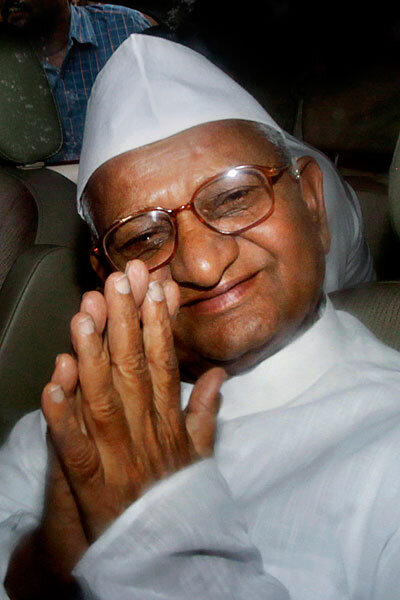What are India's Anna Hazare protests all about?
Loading...
| New Delhi
Thousands of protesters converged in New Delhi and other Indian cities Tuesday demanding the creation of an independent and powerful agency to prosecute corruption. The cause appears to be gaining momentum, posing a significant challenge to the weakening government.
Leading the charge is Anna Hazare, an elderly activist who began an "indefinite" fast today. The government detained him along with thousands of his supporters, many of whom voluntarily boarded police buses.
“This is a revolution. This is a new beginning. These people in government are burglars,” says C.P. Thakur, a lawyer who joined the street marches, which included young and old, mostly middle class Indians.
Some of the activists are ambitiously reaching for the mantle of the Arab Spring or Mahatma Gandhi’s independence struggle. But the debate hinges on ideas that would be more at home in the Federalist Papers, such as separation of powers and checks and balances.
Mr. Hazare wants the proposed anticorruption agency, known as Lokpal, to have police and prosecution powers over every level and branch of government. The government wants to restrict Lokpal to making recommendations, and to exempt judges, parliamentarians, and the prime minister.
Hazare’s vision not only unnerves officials, but also some academics and activists concerned with the amount of power it would invest in an unelected body.
“When you have to deal with a local policeman, he has a stick to beat you. Now you have a bigger guy with a bigger stick to watch over him – but now you have to deal with him too,” says Usha Ramanathan, a legal researcher. “I don’t want to give anyone that kind of power.”
The street protesters, however, clearly want a little more stick applied to the pervasive problem of corruption.
Examples of frustration
One protester, a retired colonel named J.P. Bhatia, gave an example from his own life. A faulty electricity meter at his home is overcharging him by more than $100 every month. He complained to the government engineer, who confirmed the problem and ordered it fixed in April – but it remains broken.
“Everywhere there is bureaucratic delay to extract money,” he says.
Colonel Bhatia admits he could file a petition to find out who is sitting on the case. India’s Right to Information Act (RTIA) forces government to respond to any citizen’s questions within 30 days.
The dilemma: When information finally does come back proving wrongdoing, then what?
“I’ll have to go to consumer court, but it could take my lifetime,” says Bhatia. “There have been cases in the country going for 20 years, even 40 years.”
Many protesters expressed frustration by the lack of punishment in the string of high-profile scams by top officials recently.
Vanita Deshmukh, a newspaper editor and Hazare supporter in Pune, pointed to the corruption surrounding last year’s Commonwealth Games. RTIA requests uncovered misdeeds by organizers. Some have been arrested, but the process is moving too slowly for many Indians embarrassed by the tarnishing of the country’s international image.
“All the documents proved so many things,” says Ms. Deshmukh. “After finding this, what do you want to do, just scream and shout headlines in your newspaper?”
What the Lokpal could do
The Lokpal pushed by Hazare could reclaim money from officials by docking their salaries and seizing their assets. It also has the unilateral powers to suspend or dismiss officials – though criminal cases would still go through the current judicial system.
The power to dismiss officials would give the Lokpal powers close to a court, says Nikhil Dey, a pioneering RTIA activist.
“That to me is an indication of [the Lokpal] being investigator, prosecutor, and judge,” says Mr. Dey. It puts “far too much power in one body, which could destroy checks and balances and separation of powers.”
Ms. Ramanathan says Hazare’s Lokpal would be a “huge, monstrous structure” with staff on the scale of 15,000 officials around the country. She and Dey argue for smaller, decentralized solutions – judicial reform among them.
Deshmukh says she would welcome judicial reform too, but many judges have been shown to be corrupt, so the first step is to make sure they are not exempted from Lokpal.
Critics of Lokpal, however, point out that the agency could become filled with corrupt people as well. Removing a top Lokpal official requires a Supreme Court inquiry, while adding one is the decision of government and civil society leaders – not voters.
Colonel Bhatia concedes this is a potential problem.
“Even the new Lokpal committee selected along the lines of Anna Hazare – they might turn corrupt,” says Bhatia. “But it will take [them] time.”





